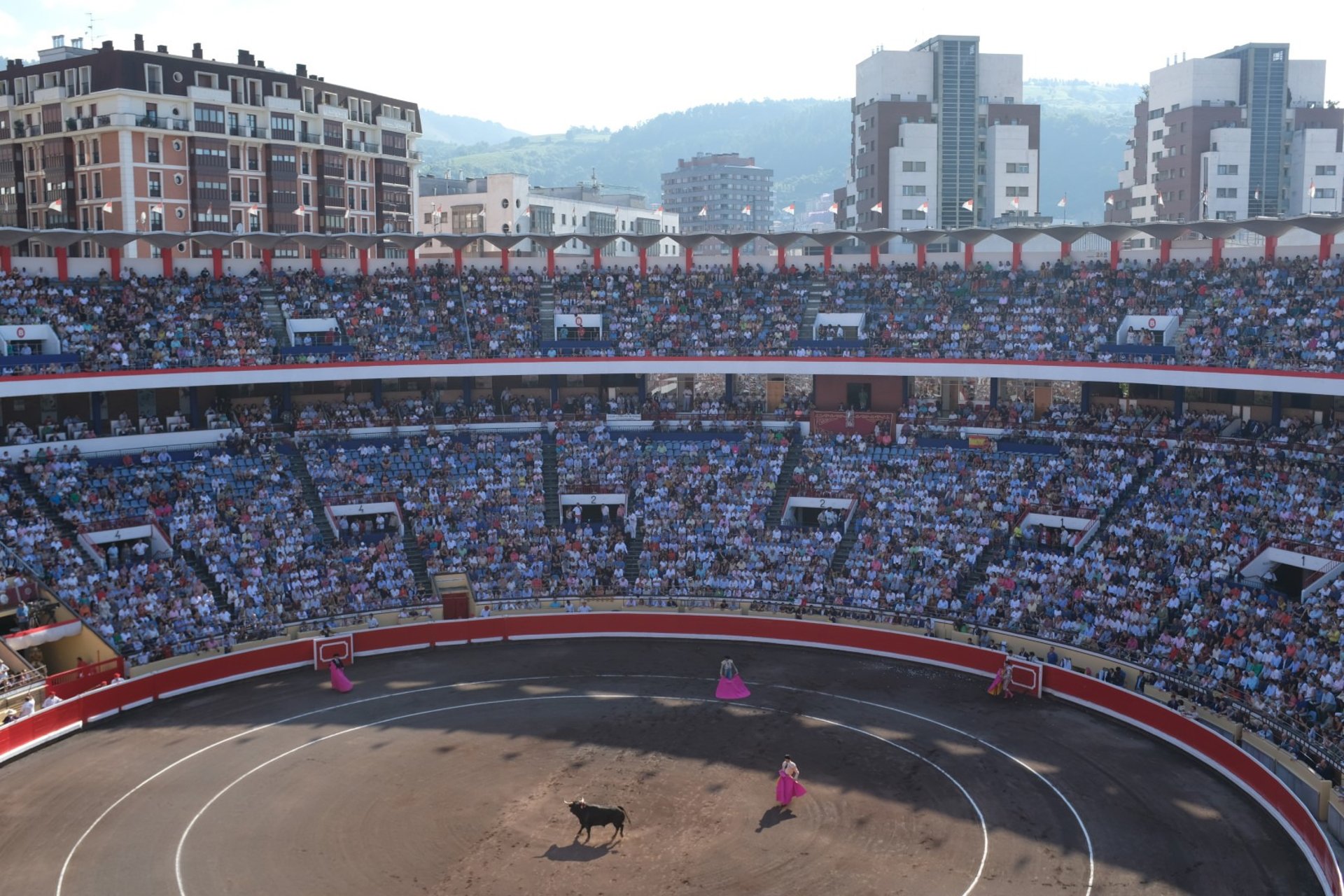
Una Polémica
2018, Bilbao, Basque Country, Aste Nagusia, Bullfighting
SPAINEUROPEANTHROPOLOGYFESTIVALS
"Una polémica", noted Alfredo, "a controversy". His eyes were looking at his memory. "There is some disagreement about the ears. They are saying he should not have taken two". I asked him what he reckoned himself, and he made an equivocal shape with his mouth, pressed his finger tips together, then looked back at me. "One, yes. Two... two is for the best. The best". We were coming down the steps out of the bullring and I was buying time, letting him wait for a proper answer to his earlier question—what were my impressions of my first corrida de toros? Three months later and I'm still chewing on it. Translated literally, the "running of the bulls" is what English speakers know as the bullfight. In Bilbao the bulls don't run through the streets, as still happens in Pamplona, but the main event is just as climactic. It had been heavy in my imagination from reading Hemingway's The Sun Also Rises, and some preordained appointment seemed to confirm itself when I heard that the corrida had not only come to town for the fiesta, but that my school—Instituto Hemingway—would be providing free tickets and the company of an experienced aficionado to any student interested in going. I didn't hesitate long before putting a pen to the sign-up page, though as I did so I knew I was committing to go and watch what many people soberly consider a gross display of animal cruelty. "Six bulls — dead" said José, the school administrator. He swept his palm in a flat line as he sounded the last word. I assured him that I understood, and put the thought away until the day. I reasoned that having seen this thing, which would happen with or without me, I would earn some enhanced right to comment on it. But to be honest with you, any intellectual kind of interest I had was only a veneer on that same dark curiosity that attracts most people to the event. That being the same thing, maybe, that makes people tell ghost stories, watch horror films, or generally desire to be shocked and shaken out of ordinary life every once in a while.
Six bulls — dead
I arrived at the Plaza de Toros de Vista Alegre, late and sweating, and a little surprised by the size of the crowd gathering at the entrance. I spotted some of the other students though, and soon Alfredo appeared and strode towards us, nodding a head or two taller than everyone around him and raising a bundle of tickets in his hand. He would be our guide for the evening. The crowd were waiting to see the matadors (literally, the killers) and their assistants arrive, and I caught my first glimpses of the men and horses in regalia. We bounded up the stairs within the rim of the building and passed through to the stands where the great circle opened out in front of us. Our tickets were in the cheaper seats in the full blast of the afternoon sun, and the air was hot and heavy with anticipation. Organically, the din of the crowd slowly softened. Then suddenly, a brass band shot an opening volley of music through the thick atmosphere. To the music, the matadors and their retinue filed into the ring to introduce themselves to their audience. Each matador was accompanied by a team of two picadores (lancers) on horseback, three banderilleros (flagmen) and a mozo de espada (sword boy). All were dressed spectacularly, yellow jackets paired with pink stockings, black with red, green on white. The whole event is highly ritualised, and is split into three parts.
Plaza de Toros de Vista Alegre
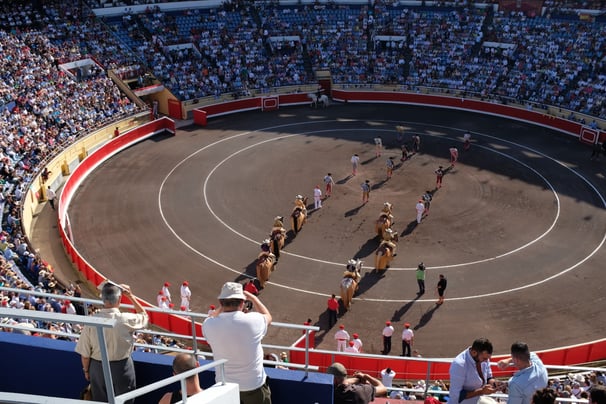

The first part is called the Tercio de Varas, the Third of Lances. The three banderilleros take up positions at a distance from one another, and after a tense silence the gate to the bull's pen is opened and the animal thunders into the ring. At this moment the reality lands. You understand that it is a real, conscious and perceiving creature, with a half ton of muscle and horn at its command. Often almost immediately the bull picks out one of the flagmen and charges him, only to be diverted by the brilliant pink flash of his cape. The team of flagmen take turns drawing the bull on them, opening the long process of tiring the animal out. The matador only observes the bull during this sequence, assessing his strength, the way he uses his charge, whether he has a preference for a certain part of the ring. This introductory stage is still full of drama, however. I remember one bull in particular, enraged after his first two charges were frustrated, how he scraped the ground and stomped his feet. He charged again, and one of the banderillos underestimated how quickly he would turn for the follow up. Too close to control the fresh charge with his cape, he sprinted to the edge of the ring—the animal right behind him—and vaulted over to safety, the crowd heaving with him.
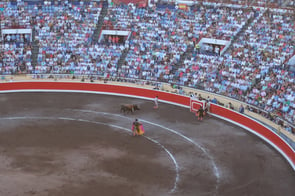



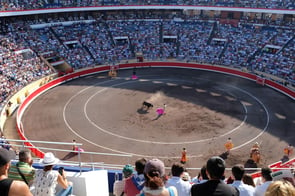
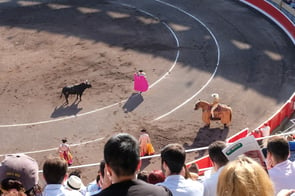
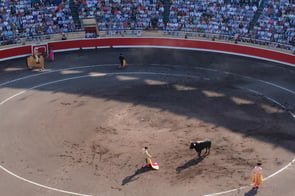
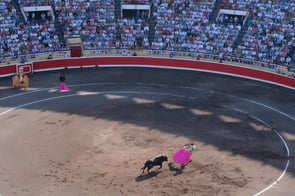




Tercio de Varas
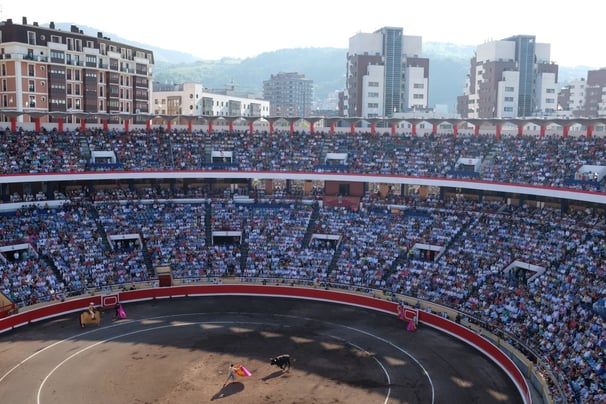

Upon the entrance of another bull, one of the banderilleros knelt down flat on his heels right in front of the bull's gate, his sheet of pink fabric held out in front of his chest. There couldn't have been a set of eyes in the whole arena that weren't fixed on him as the bull emerged and closed the few metres, horns down. The man kept his torso fixed rigid, and cast his cape to his right only at the last second. The bull barrelled after it, and his left horn dug into the earth of the ring. To gasps from the crowd, the beast finished his charge with his head stuck awkwardly under a front leg. After a moment he righted himself, but he was limping—it seemed to me that he had broken or badly injured the limb. The other banderilleros tried to draw him once or twice more, but it became clear that the animal could not finish the show. The crowd took no pleasure in the display, and seemed to utter a long murmur of collective embarrassment. "Pobrito", whispered a woman in the stands behind me, "poor little one". The men withdrew from the ring, and after a tense moment the bull's gate opened. Into the ring came three steers. These are bulls that have been neutered, lacking the muscular frame of the fighting bull. I knew from Hemingway that their function is to calm down and lead out a fighting bull which must be removed from the ring alive. I also knew from Hemingway that there was a chance the bull would gore and kill one or more steers in the attempt, and so I was right back on the edge of my seat. Happily, this bull no longer wanted to fight, and he went out quietly with the little herd.
All of the other bulls I saw though did remain in the ring to endure the next set of trials. The trumpeters lead the band into a new refrain, and the flagmen close in on the bull. They continuously cast their capes left and right, keeping him distracted in a far corner of the ring while the first picador enters on horseback. He trots slowly, evenly, holding a lance high above his head. His horse is heavily armoured in padding, the eyes blinkered. Once the right distance from the bull has been achieved, the flagmen withdraw, and the bull spots the cavalry man. Quickly he takes aim at the horse's centre of gravity and charges, and as he does so the picador lowers his vara and points it to strike the bull in the morillo, a mound of muscle above the animal's neck. The two impact at once—the bull slamming into the horse with a gut-churning thud and the rider piercing the bull, then leaning into the lance. In this way, the first blood is drawn in the ring. In the past the horses did not wear armour and were regularly gored to death by the bull, but today the practice is illegal. Even with the reassurance of the protection though, I saw many turns where the bull hit the horse so hard it was lifted partly off the ground and driven far back, or where the bull tried furiously to hook his horn under the belly. Nevertheless, the horses seem to endure the whole process stoically. The second picador repeats the clash with the bull, weakening him significantly, and then the banderilleros re-enter the ring and keep the bull distracted while the riders exit. Once or twice there was a turn where the bull refocused on the picador at a distance, raising the prospect of a charge at full momentum across the ring. This was averted only by the nervous shouts and whirling capes of all three flagmen.
Tercio de Banderillas
The second part is called the Tercio de Banderillas, The Third of Little Flags. Three men enter, this time without protective capes. A trumpeter chortles off a merry tune, something I later felt contrasted bitterly with the violence of the sequence. The men carry barbed batons with coloured flags attached, called banderillas, little flags, one in each hand. While another flagman with a cape distracts the bull, one of these stick bearers stalks around the animal to a good distance. He raises his weapons up like pincers. The band falls silent, and with a little shout he catches the bull's attention. As the animal prepares to charge him, he runs to meet him at an angle, and then in one fluid motion he plunges the barbs into the bull's back, spins around and runs, then leaps to safety over the edge of the ring. The ordeal is repeated with another two pairs of banderillas, leaving the bull with six of the batons hanging from his back. As cruel as this sounds, I was told that the bull does not feel much pain from wounds to this part of his body. This is not implausible—the bulls made no sound when struck in this way, and didn't seem to pay much attention to the banderillas once they had been attached. Only one of them tried for a moment to shake them off, and I noted that several bulls continued little body motions that seemed to indicate relative composure, like flicking the tail back and forth while at rest between charges. At the same time, by this stage it's clear that the bull is tiring. His torso pulses with heavy breaths and the coloured flags of the banderillas do little to disguise the blood running down his back. I remember one bull at this point looking from target to target, still fiercely aiming his horns at each man in turn, but becoming unsure, confused. The sympathy of much of the audience shifts to the animal, particularly if he has fought vigorously, or at the other extreme if he does not seem fit for the ring or if he has been wounded other than in the prescribed way.
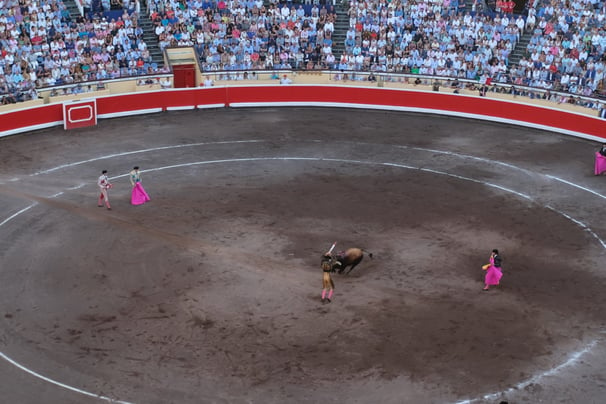

Tercio de Muerte
The third part is called the Tercio de Muerte, the Third of Death. Now the matador strides into the ring, dressed like a superhero in his traje de luces (suit of lights). The two I remember best were a senior Spanish fighter decked out in gold and blue, and a rising star from Peru in a pristine white suit. Both wore bright pink stockings and carried a blood red muleta, the special matador's cape supported by a rigid stick. As the Peruvian crossed the centre of the ring, he threw his hat up in the air. It landed flat upright on the ground, raising cheers from the crowd. The bull he faced was black, contrasting perfectly with the attire. After a brief stare-down, he lifted his cape and pointed its spine, then slid his arm in a stiff arc towards the bull. "Toro!". The bull rolled his head and charged, but found nothing behind the muleta. "Olé!" came the cheer from the crowd. The bull turned and charged again, and again he found himself ushered harmlessly away. Again, again, "Olé! Olé!". The bull turned once more to the matador, but now only stood and watched the man in confusion. The matador turned his back to the bull and strolled away triumphantly, flicking back a mop of dark hair and soaking up the rich applause from the crowd. When he'd had enough of it, he slowly aimed the edge of the muleta back at the bull. "Ha! Toro!". With a ferocious bellow, the bull literally leapt into a fresh charge. As he met the matador there was a shock as he suddenly jerked his left horn into the charge, narrowly missing the man's ribs and making the crowd gasp. But the matador steadied himself and drew the bull into a volley of passes; two, three, four, five, and finishing the set with a playful tap of his sword on the bull's forehead. The bull turned back to the man and stood stupefied. The matador swung his sword in the air triumphantly and again he walked away with his back turned, as if the show were over. Now the bull circled away, crossing the centre of the ring as he did so. He trampled the matador's hat, leaving it upside down, and the crowd roared. Unfazed, the matador observed the movement calmly and closed the distance with the bull in a slow saunter. Then he leaned back at a slight angle and shimmied his feet along the ground, edging towards the beast with his muleta aimed dead ahead.
Now a new trick. The bull began his charge, and the matador held out his cape to his right. But before the bull could close the distance, the man shot the cape over to his left. The bull's lethal trajectory passed in a blink from one path of diversion, across the bolt rigid body of the man, to a fresh diversion in the other direction, and the crowd erupted in applause. Another volley of passes, and yet again the beast found himself at a loss. The matador strolled casually to the centre of the ring, and with a flick of his sword, he flipped his hat back over, right side up. The crowd went wild, and the band broke into a rousing tune.
With one hand thrown back, now the matador invited the bull to dance. One, two, three, his body ever closer to the path of the horns; four, five, six; seven, to cries of "Ole!" and ripples of applause. One final trick. The matador strode forward and planted his body directly in front of the horns of the now exhausted, motionless animal. He let the muleta glide behind his back, and he swept it back and forth behind his legs like a pendulum. The bull's head tracked it, and though he was weary, it seemed he only had to jab his horns up to kill the man. But instead, he only stood mesmerised, his head swaying back and forth with the swishes of the cape. After some heavy moments, the matador brought his cape back around, and with a flick of the fabric he commanded the bull to charge for a final series of passes, finishing off once more with his trademark upward sweep of the sword. Now the band stopped, and all noise seemed to be strained out of the crowd, sucked down an invisible sinkhole in the centre of the ring.
They say there is a correct way to kill a bull. The matador must stab him in one motion, cleanly through the morillo, and the beast will fall more or less instantly. Our Peruvian approached the black bull almost gently, almost in friendliness. The entire arena was mute. He raised and pointed his sword, fixating on his mark. Then with his muleta low to the ground, he gave a little shout and flicked it backwards, making the bull charge with his head low, exposing the morillo. With that he plunged his sword into the creature, and the crowd exhaled. But the bull did not fall. There followed a few excruciating minutes as the flagmen entered to distract the bull until the sword could be plucked out of his back, and then the true finale came. Again the slow approach, again, the last charge. It seemed we all were praying the matador would succeed. He did. This time the sword went straight to the centre and deep, and the bull staggered away to the side of the ring, though still keeping his horns alternating between the matador and the flagmen at the perimeter. At last, his legs buckled, and he came down to the earth. There was applause from the crowd as the judges gave their rating from the stands, and the matador went to claim his prize. Savagely, he cut off both of the creature's ears, as trophies. As rapt as I'd been with the show, I couldn't assent to this last gratuity. Finally, as happens with all the bulls, a horse-drawn carriage entered the ring and the dead beast was tied to it by his horns, and then dragged out.
I did see another bull killed in a single stroke. I also saw a bull, a poor brown fellow, who received three strikes before his suffering was finished. From the beginning of that fight he had seemed unsteady on his feet and reluctant to engage the banderilleros. By the time he faced the matador, it was clear that he was afraid and confused, bewildered by his tormentors. It was an ugly show, and many in the crowd, perhaps sensing their complicity in it, openly called for it to end. The bull did not want to fight, and I wondered if that had made the path of his charges hard to predict. When the matador went for the killing stroke he did so poorly, not straight to the centre of the morillo, but at an angle. "La primera vez, coño!" one man yelled, "The first time, pussy!". The brown bull suffered very much—he bled from his mouth, and he bellowed loudly as he died, as if to say, simply "let me be". There was neither applause nor fanfare as his body was dragged out of the ring.
By contrast, the corpse of the black bull was followed out by the appreciation of the crowd. Their cheers rose like a wave, upon which the matador then surfed, parading around the ring. He retrieved his hat and paused to pivot in a slow salute toward the stands, and the rest of the performers then entered to share in the celebration. They hoisted the young Peruvian up on their shoulders to carry him out, and an undercurrent of controversy emerged out of the vigorous applause. I turned and tried to follow the Spanish of some men in the row behind us. Smiling, they launched arguments at one another and threw their arms up and out, imploring those around them to take their side. Alfredo offered them some remarks, and amid much backslapping, head-shaking and gesticulating, they invited us to drink with them. "Una polémica", said Alfredo, “a controversy”, breaking my brow-furrowed silence for me on the way out.
The corrida is something from another time—it made me think of pagan sacrifices and Roman gladiators. Maybe for exactly this reason, in the middle ages the Catholic church tried to eliminate it through excommunication. Though the upper classes eventually became embarrassed by the tradition, the common people of Iberia kept it alive and carried it forward to the present day. The prevailing morality now is against it too, and increasingly so. When I went, the stands were not full, and more than a few of the heads present were grey. If it was all going to be finished tomorrow, you wouldn't hear any complaint from me. But I do think that something would be lost. It might seem counter-intuitive, but the aficionados will tell you that they love the animals. The bullfight is a story about living and dying, played out for real. At any rate it's real for the bull, and if the matador is a good one, his part in it is sincere as well. The head of it all is that you find yourself putting beauty and death in the one sentence. I can't agree that our entertainment is worth the blood of a living thing, but I will argue that this tradition is not simple sadism. I think the bull stands in for Death itself, and what sends shivers down the spine is that a man goes to meet it with a smile. In our comparatively safe, sterilised modern world, the rule is not to think about dying. Here in contrast is an echo from a time when people lived closer to it, and perhaps were more frank about it, more earnest. In the same way, today it's easy to close your eyes to what you do to the natural world. The food I eat comes from somewhere far away, and I can pretend I had no hand in what was done to put it on my plate. At the corrida the audience do not carry the sword, but they witness its use and thus take ownership of the violence. Far better perhaps the bullring, where a creature is acknowledged and celebrated, even as it is killed, than the battery cage where living things are thanklessly turned into raw material in the dark. If you ever think of going though, take it seriously. This is not light entertainment, not easy to watch, nor to forget.
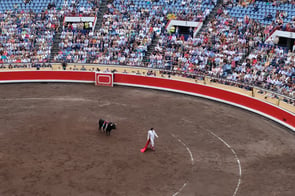
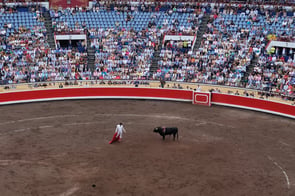
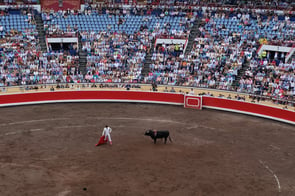
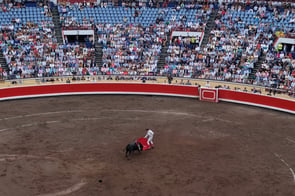




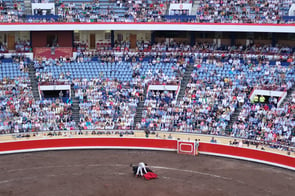
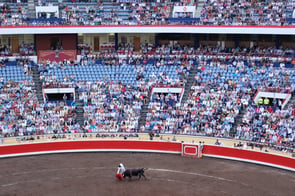


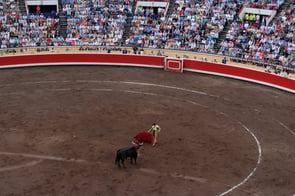
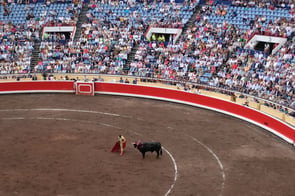


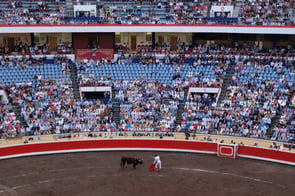
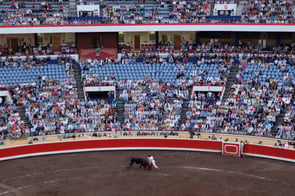


The Gist: Bilbao
ARRIVED: I flew to Bilbao with Aer Lingus from Dublin. The city is also served by low-costers such as Ryanair. There is also a ferry connection between Ireland (Rosslare) and Bilbao operated by Brittany Ferries, which I plan to use for any future return trips to northern Spain, thinking of my carbon footprint. From Bilbao, there are good rail and bus links to other cities in northern Spain as well as Madrid, and Biarritz in France. If you'll take more than a few trips within the city it's worth getting a Barik card for public transport in and around Bilbao. A shuttle bus connects the airport with the city centre.
SLEPT: I stayed in a shared apartment in the city centre organised by my school, Instituto Hemingway.
DID: My trip was centered around a short Spanish language course at Instituto Hemingway. The travel highlights for me in Bilbao besides the Corrida de Toros were the Gugheim Museum, the city's river front, the Aste Nagusia festival, Puente Colgante, and the food culture, especially Pintxos! Venturing a little further out, I loved the beach at Arrietara, Gaztelugaxte. Going beyond Bilbao's hinterlands, San Sebastián was a great day trip. For more on this extended itinerary, see my post "Basque in the Limelight".
LEFT: I flew back to Dublin with Aer Lingus.

